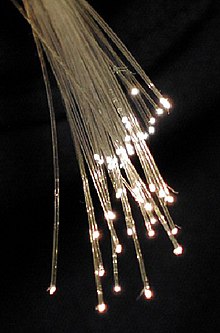
Fluoride glass is a class of non-oxide optical glasses composed of fluorides of various metals. They can contain heavy metals such as zirconium, or be combined with lighter elements like aluminium and beryllium. These heavier elements cause the glass to have a transparency range extended into the infrared wavelength.[1]
Thus, the goal for heavy metal fluoride glasses (HMFG) is to create ultra-low loss optical fiber communication systems for commercial and defense applications as well as bulk components that can be used in invasive medical treatment. However, the heavier elements also cause the glass to have a low viscosity and make them vulnerable to crystallization during the glass transition or processing. This makes the glass more fragile and have poor resistance to moisture and environmental attacks.[2]
Fluoride glasses' best attribute is that they lack the absorption band associated with the hydroxyl (-OH) group (3.2–3.6 micrometers) which is present in nearly all oxide-based glasses.[3]
- ^ Aggarwal, Ishwar D.; Lu, Grant (2013-10-22). Fluoride Glass Fiber Optics. Academic Press. ISBN 978-1-4832-5930-7.
- ^ Rault, G; Adam, J. L; Smektala, F; Lucas, J (2001-08-29). "Fluoride glass compositions for waveguide applications". Journal of Fluorine Chemistry. Solid State Inorganic Fluorides. 110 (2): 165–173. doi:10.1016/S0022-1139(01)00425-0. ISSN 0022-1139.
- ^ heavy-metal fluoride glass (glass), Britannica Online Encyclopedia
